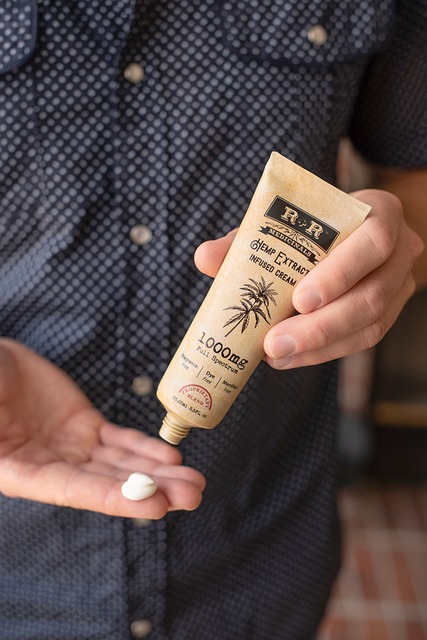High-potency cannabinoids, found in strong cannabis strains with elevated THC levels, offer significant therapeutic benefits but should be used with caution due to potential side effects. Understanding different strains' cannabinoid profiles and dosage guides is crucial for safe consumption. Individual variations in metabolism, genetics, and cannabinoid type affect response, so starting with low doses and gradually increasing is recommended. Various administration methods – oral, sublingual, vaporization – cater to user preferences. Interpreting lab reports ensures product quality and purity. A gradual approach, beginning with low doses, builds tolerance and minimizes side effects like anxiety. Tracking intake through journaling helps tailor dosage and adjustments based on individual responses.
In today’s market, high-potency cannabinoids are becoming increasingly prevalent. Understanding their dosage can be complex, as individual responses vary greatly. This comprehensive guide aims to demystify high-potency cannabis usage. We’ll explore why dosage guides are crucial for optimal effects, delving into factors influencing intake and safe administration methods. By understanding lab reports, starting low, and tracking adjustments, users can navigate high-potency cannabinoids with confidence, ensuring both safety and efficacy.
Understanding High Potency Cannabinoids: A Comprehensive Overview

High-potency cannabinoids, often referred to as high THC or potent cannabis strains, have become increasingly popular among consumers seeking more intense effects. It’s essential to understand that these compounds, primarily tetrahydrocannabinol (THC), are powerful psychoactive molecules known for their mind-altering properties. They interact with the body’s endocannabinoid system, influencing various physiological and cognitive functions.
While high-potency cannabinoids offer potent therapeutic benefits for specific medical conditions, they should be approached with caution. The potency can lead to more pronounced side effects, including increased heart rate, anxiety, and potential paranoia. Different strains vary in their cannabinoid profiles, allowing consumers to choose options better suited to their needs and tolerance levels. Educating oneself about these compounds is crucial, especially when navigating the diverse cannabis market to ensure a safe and enjoyable experience.
Why Dosage Guides Are Essential for Effective Use

Dosage guides are essential tools for anyone looking to harness the potential benefits of high potency cannabinoids. In a world where cannabis products come in various forms and concentrations, understanding how much to take can be overwhelming. These guides serve as a roadmap, ensuring consumers make informed decisions about their usage. With the rise in popularity of potent CBD and THC oils, edibles, and concentrates, it’s crucial to have reliable information on hand. They provide a starting point for users, offering recommendations based on factors like age, weight, medical history, and desired effects.
Accurate dosage guides empower individuals to avoid under or over-ingesting, which can lead to unwanted side effects or a lack of desired results. They foster responsible use, especially for newcomers to the cannabis space. By understanding appropriate dosages, consumers can effectively manage their intake, maximise benefits, and maintain a safe and pleasant experience. This is particularly important when exploring high potency cannabinoids, where even small adjustments in dosage can have significant impacts.
Factors Influencing Cannabinoid Dosage: Individual Variations

When considering cannabinoid dosage, it’s crucial to recognize that individual variations play a significant role. Each person’s response to cannabinoids can differ greatly due to several factors. One of the primary influences is metabolism—how quickly your body processes and absorbs cannabinoids. Genetic makeup also contributes, as variations in certain genes can affect cannabinoid receptor sensitivity. For instance, individuals with higher tolerance or those metabolizing cannabinoids at different rates will require adjustments in dosage.
Another critical factor is the specific type of cannabinoid being used. High potency cannabinoids, such as THC or CBD isolate, may demand lower doses due to their concentrated nature. In contrast, full-spectrum oils or flower products with varying cannabinoid profiles might necessitate higher doses for optimal effects. It’s essential to start with a low dose and gradually increase until the desired effect is achieved, taking into account these individual variations.
Safe and Effective Administration Methods for High-Potency Products

When administering high-potency cannabinoids, it’s paramount to prioritize safety and efficacy through meticulous method selection. Oral administration remains a popular choice due to its convenience and ease; however, it’s crucial to note that onset times can be longer, ranging from 30 minutes to an hour, with effects lasting several hours. This prolonged duration might not be ideal for users seeking rapid relief.
Alternatively, sublingual (under the tongue) administration offers quicker absorption, typically taking effect within 15-30 minutes, making it a preferred method for faster results. Inhaling high-potency cannabinoids through vaporizers provides immediate effects, offering precise dosing and a cleaner experience compared to traditional smoking methods. Each method has its advantages, catering to individual preferences and specific needs.
Interpreting Lab Reports and Ensuring Product Quality

Interpreting lab reports is a crucial step in ensuring product quality, especially when dealing with high potency cannabinoids. These detailed reports provide insights into the chemical composition and purity of cannabis-based products. By analyzing data on cannabinoid concentrations, residual solvents, and potential contaminants, consumers and healthcare professionals can make informed decisions.
When purchasing cannabis products, look for independent lab testing results that guarantee quality and safety. High-quality products should have consistent and accurate lab reports, ensuring a pure and potent cannabinoid profile. This transparency is vital in the rapidly growing cannabis industry, helping consumers navigate options and making educated choices based on reliable data.
Starting Low and Increasing Gradually: Building a Tolerance

When introducing yourself to cannabinoids, especially high potency ones, it’s crucial to start low and increase gradually. This approach allows your body to build a tolerance, ensuring a more comfortable and controlled experience. Beginning with a low dose helps prevent overwhelming your system, which could lead to unpleasant side effects like anxiety or paranoia.
By taking small increments over time, you give your body the chance to adjust. Gradually increasing allows you to gauge your personal response and determine what works best for you. This methodic approach is key to harnessing the benefits of cannabinoids while minimizing potential drawbacks.
Common Misconceptions About Cannabinoid Dosage

Many people new to cannabinoids hold several misconceptions about dosage, often driven by sensationalized claims or misinformation online. One widespread idea is that higher potency means better results, leading users to consume high-concentration products in hopes of achieving faster, stronger effects. However, this isn’t always true; excessive consumption of high-potency cannabinoids can lead to unpleasant experiences, including anxiety and paranoia, especially for those new to their use.
Another common misconception is that a one-size-fits-all approach applies to cannabinoid dosing. Every individual has a unique endocannabinoid system, which influences how they interact with these compounds. Factors like body weight, metabolism, tolerance, and personal preferences play significant roles in determining optimal dosage. Start with low doses and gradually increase as needed, allowing your body time to adjust and avoid potential adverse reactions.
Best Practices for Tracking and Adjusting Your Intake

Tracking your intake is crucial when navigating the world of high potency cannabinoids, as it allows for a personalized approach to dosing. Start by keeping a daily journal where you record each dose and its effects. Note down factors like the specific cannabinoid, concentration, and any symptoms or changes in mood, energy levels, or appetite. This practice enables you to identify patterns and understand your body’s unique response.
Regularly reviewing your intake data empowers you to make informed adjustments. If you notice consistent side effects or lack the desired effect, consider tweaking your dosage. It might be as simple as reducing or increasing the amount slightly or experimenting with different administration methods. Stay patient and consistent in your tracking efforts, as it may take time to find the optimal balance tailored to your needs.
